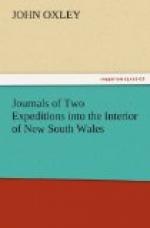October 30.—We passed for five miles and a half through the country described yesterday, when we arrived on the beach south-west of the Sugarloaf Point. The rock off ditto bearing N. 88. E.; Shoal of ditto, 120., and Blackhead, N. 212 1/2; we went nearly six miles farther on the beach, and halted near a rocky point for the evening. This beach was a peculiarly productive one to us; a great number of fine fish resembling salmon, had been pursued through the surf by larger fish, and were left dry by the retiring tide: we picked up thirty-six, and a welcome prize they proved to us. We had just got the tents pitched, when a number of unarmed natives appeared upon the hill near us, and among them a woman and a child. As they came in peace, so in peace were they received. They approached the tents without any hesitation, and in the course of an hour, their numbers amounted to upwards of thirty, men, women, and children. Most of these people seemed to have been at Newcastle, and appeared a friendly and peaceable set. We did all in our power to continue these good dispositions by shaving the men, cutting the hair of the children, and bestowing on them such little articles as we could spare; not without a hope, that our kindness might be of service to others, who might under different circumstances be thrown among them. They were so far from showing the least jealousy of their women, that every circumstance indicated that their favours might be purchased: however that may be, we did not avail ourselves of this privilege. Kindling their fires close to our tents, they seemed to have taken up their quarters for the night. The weather had appeared to threaten rain, and as they all departed about ten o’clock, it was attributed to the circumstance of their being without shelter; and we expected a friendly visit from them in the morning. From this station, Blackhead bore N. 197.; and the island off Sugarloaf Point, N. 70. E. The peak over the north entrance into Port Stephens, N. 211.




